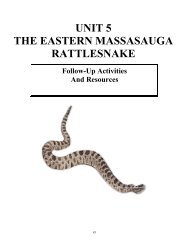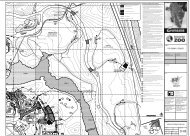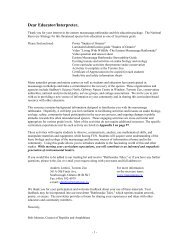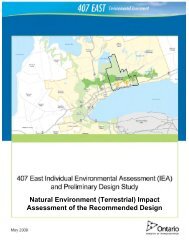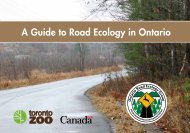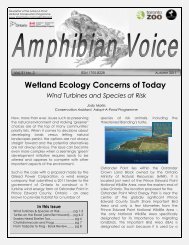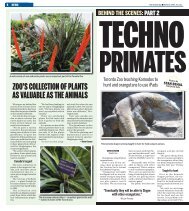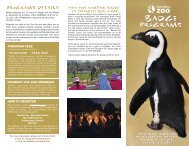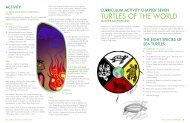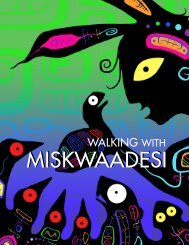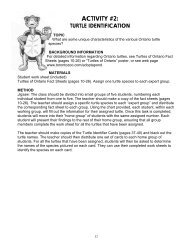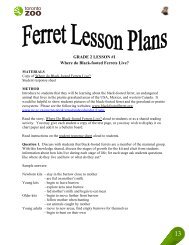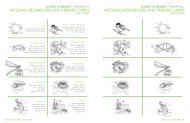Turtle Identifier Cards - Toronto Zoo
Turtle Identifier Cards - Toronto Zoo
Turtle Identifier Cards - Toronto Zoo
Create successful ePaper yourself
Turn your PDF publications into a flip-book with our unique Google optimized e-Paper software.
TURTLE IDENTIFIER CARDS<br />
Blanding’s <strong>Turtle</strong><br />
Smooth, domed carapace with<br />
yellow streaks or splotches<br />
Size:<br />
12.5 to 18 cm<br />
Lives In:<br />
soft-bottomed waters with<br />
dense aquatic vegetation<br />
Eats:<br />
crayfish, insects, frogs and plants<br />
Other:<br />
• the plastron is hinged to protect the head<br />
of the turtle when recoiled<br />
• high domed carapace and yellow<br />
chin.<br />
Chin and throat are<br />
bright yellow<br />
Protruding eyes<br />
Northern Map <strong>Turtle</strong><br />
Carapace is olive green with fine yellow lines<br />
running down its surface<br />
Size:<br />
(males) 9 to 15.9 cm<br />
(females) 18 to 27.3 cm<br />
Lives In:<br />
larger rivers and lakes (slow<br />
moving water with a soft<br />
bottom)<br />
Eats:<br />
Other:<br />
molluscs, insects, fish, carrion and<br />
plant material<br />
• a yellow spot is located behind each eye<br />
• map-like markings on shell<br />
• rear edge of shell is serrated<br />
Head and limbs<br />
have yellow stripes<br />
Carapace is oval with<br />
a serrated edge and<br />
slightly raised keel<br />
39
TURTLE IDENTIFIER CARDS<br />
Common Musk <strong>Turtle</strong><br />
A yellow stripe is located<br />
above and below the eye on<br />
both sides of the head<br />
Carapace is domeshaped<br />
and smooth and<br />
is light olive to black in<br />
colour<br />
Size:<br />
Lives In:<br />
Eats:<br />
Other:<br />
5.1 to 11.5 cm<br />
often in shallow areas of soft-bottomed,<br />
slow moving water (e.g. rivers, lakes and ponds)<br />
algae, carrion, small invertebrates, fish eggs,<br />
minnows and tadpoles<br />
• Ontario’s smallest turtle<br />
Chin and throat are<br />
covered in barbels<br />
Common Snapping <strong>Turtle</strong><br />
Long serrated tail<br />
Carapace is olive, tan,<br />
light brown or black in<br />
colour<br />
Size:<br />
Lives In:<br />
Eats:<br />
Other:<br />
20.3 to 36 cm in carapace<br />
length<br />
slow-moving water with a soft<br />
bottom and plenty of vegetation<br />
(e.g. shallow ponds, rivers,<br />
streams and canals)<br />
fish, invertebrates, plants, turtles,<br />
snakes, young waterfowl and small mammals<br />
• Ontario’s largest turtle<br />
Head has two barbels on chin<br />
40
TURTLE IDENTIFIER CARDS<br />
Only turtle in Ontario with a<br />
soft, leathery carapace<br />
Carapace is olive-grey to brown<br />
with a yellow border<br />
Eastern Spiny Softshell <strong>Turtle</strong><br />
Size:<br />
Lives In:<br />
Eats:<br />
Other:<br />
12.2 to 23.5 cm<br />
rivers or lakes with soft,<br />
sandy bottoms and lots of aquatic<br />
vegetation<br />
insects, fish and crayfish<br />
• carapaces are smooth in females and covered in tiny<br />
• spines in males<br />
• pliable, leathery shell<br />
Very long neck with a ‘pig-like’<br />
nose<br />
Painted <strong>Turtle</strong><br />
Smooth, flat carapace that is<br />
olive to black in colour<br />
Size:<br />
Lives In:<br />
Eats:<br />
Other:<br />
11.5 to 14 cm (Midland subspecies)<br />
9 to 18 cm (Western subspecies)<br />
ponds, marshes, lakes and creeks (prefer<br />
soft-bottomed bodies of water with many<br />
basking sites)<br />
aquatic plants, frogs, small fish and<br />
aquatic invertebrates<br />
• often seen basking together<br />
Neck, legs and tail have<br />
yellow and red stripes<br />
Red markings on<br />
outer scutes<br />
41
TURTLE IDENTIFIER CARDS<br />
Dark carapace with small, bright<br />
yellow or orange spots<br />
Spotted <strong>Turtle</strong><br />
Size:<br />
9 to 11.5 cm<br />
Lives In:<br />
bogs, marshes, and soft- bottomed<br />
lakes<br />
Eats:<br />
snails, aquatic insects and vegetation<br />
Other:<br />
• males have a tan chin<br />
and brown eyes while females<br />
have a yellow to orange chin and<br />
yellow to orange eyes<br />
Carapace is very<br />
smooth<br />
Head, neck and<br />
limbs are grey to<br />
black with yellow<br />
spots<br />
Carapace is brown to<br />
greyish-brown to yellow in<br />
colour<br />
Concentric growth<br />
rings on each scute<br />
Wood <strong>Turtle</strong><br />
Size:<br />
Lives In:<br />
Eats:<br />
Other:<br />
14 to 20 cm<br />
woods, shrub or berry thickets,<br />
swamps, streams and open grassy<br />
areas<br />
terrestrial plants, mushrooms,<br />
insects and worms<br />
• Ontario’s most terrestrial turtle<br />
Head and upper limbs are black. The neck<br />
and lower limbs vary in colour from yellow<br />
to orange to reddish depending on where<br />
they live<br />
42



